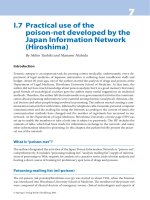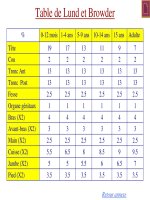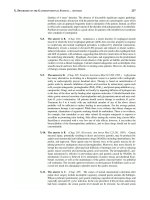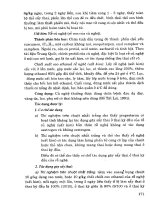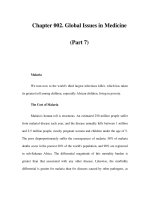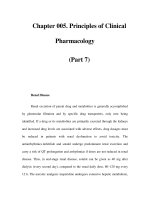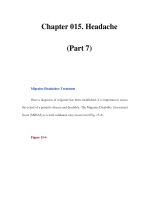Chapter 036. Edema (Part 7) pptx
Bạn đang xem bản rút gọn của tài liệu. Xem và tải ngay bản đầy đủ của tài liệu tại đây (11.85 KB, 5 trang )
Chapter 036. Edema
(Part 7)
Additional Factors in Diagnosis
The color, thickness, and sensitivity of the skin are significant. Local
tenderness and warmth suggest inflammation. Local cyanosis may signify venous
obstruction. In individuals who have had repeated episodes of prolonged edema,
the skin over the involved areas may be thickened, indurated, and often red.
Estimation of the venous pressure is of importance in evaluating edema.
Ordinarily, a significant generalized increase in venous pressure can be recognized
by the level at which cervical veins collapse (Chap. 220). In patients with
obstruction of the superior vena cava, edema is confined to the face, neck, and
upper extremities, in which the venous pressure is elevated compared with that in
the lower extremities. Severe heart failure may cause ascites that may be
distinguished from the ascites caused by hepatic cirrhosis by the jugular venous
pressure, which is usually elevated in heart failure and normal in cirrhosis.
Determination of the concentration of serum albumin aids importantly in
identifying those patients in whom edema is due, at least in part, to diminished
intravascular colloid oncotic pressure. The presence of proteinuria also affords
useful clues. The absence of proteinuria excludes nephrotic syndrome but cannot
exclude nonproteinuric causes of renal failure. Slight to moderate proteinuria is the
rule in patients with heart failure.
Approach to the Patient: Edema
An important first question is whether the edema is localized or
generalized. If it is localized, those local phenomena that may be responsible
should be considered. If the edema is generalized, it should be determined, first, if
there is serious hypoalbuminemia, e.g., serum albumin <25 g/L. If so, the history,
physical examination, urinalysis, and other laboratory data will help evaluate the
question of cirrhosis, severe malnutrition, or the nephrotic syndrome as the
underlying disorder. If hypoalbuminemia is not present, it should be determined if
there is evidence of congestive heart failure of a severity to promote generalized
edema. Finally, it should be determined whether the patient has an adequate urine
output, or if there is significant oliguria or anuria. These abnormalities are
discussed in Chaps. 45, 273, and 274.
Further Readings
Abassi ZA et al: Control of extracellular fluid volume and the
pathophysiology of edema formation, in The Kidney
, 7th ed, BM Brenner (ed).
Philadelphia, Saunders, 2004, pp 777–856
Chertow GM: Approach to the patient with edema, in Car
diology for the
Primary Care Physician
, 2d ed, E Braunwald, L Goldman (eds). Philadelphia,
Saunders, 2003, pp 117–128
Diskin CJ et al: Edema, oncotic pressure, and free entropy: Novel
considerations for treatment of edema through attention to thermodyna
mics.
Nephron 78:131, 1998 [PMID: 9496727]
McCullough JC: Renal disorders and heart disease, in
Braunwald's Heart
Disease, 7th ed, D Zipes et al (eds). Philadelphia, Saunders, 2005
O'Brien JG et al: Treatment of edema. Am Fam Physician 71:2111, 2005
[PMID: 15952439]
Streeten DH: Idiopathic edema. Pathogenesis, clinical features, and
treatment. Endocrinol Metab Clin North Am 24:531, 1995 [PMID: 8575408]
